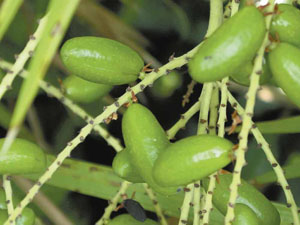  |
||||
| Home | Books | Recent Writing | ||
|
Saw Palmetto
The saw palmetto or Serenoa repens is indigenous to the southeastern United states and the islands of the West Indies. Its natural habitat ranges from as far north as South Carolina and west into Texas. Currently the main supplier of saw palmetto is the state of Florida with the harvesting of wild crops occurring mostly in the central part of the state. The berries are used in the natural health industry as a supplement, particularly for men experiencing prostate problems. According to Dr. Don Gardner, county coordinator, and Roberta Gray, county agent with the UGA Cooperative Extension Service here in Glynn County they are unaware of anyone taking advantage of harvesting those berries. That may be because picking the berries is hard, unpleasant and sometimes dangerous. Rattlesnakes are common in the thickets. Humid heat, turning the palmetto patches into steam baths, is a more constant foe. Most of the time, harvesters pick along roadsides and in vacant lots in peace. But trespassing is also a possibility and harvesters need to be aware about where they are and whether or not they are trespassing. Those who harvest berries can make up to one dollar a pound, depending on the weather conditions that year. A poor crop yields higher prices. Once bought, the sacks of berries are poured into wooden bins big enough to hold 1,200 pounds of the fruit. The bins are loaded onto semi trailers and hauled away to be dried for preservation. The saw palmetto plant is best described as a palm shrub. The plants grow in large colonies of a hundred or more. Each plant produces 3 to 7 fan shaped leaves which grow to about two feet in width. In the spring, the plant produces small white flowers which produce the fruit of the saw palmetto, a small berry. As just discussed, the berries are harvested in the fall after they mature.
The saw palmetto was once a staple food of the Native American population in the southeastern United States. They are known to have used the berries both as a food source and for its medicinal qualities. Historically, saw palmetto was taken with nettle root and pumpkin seeds, and as a result some modern formulations include these elements. Native American medicine men are said to have used the berries as treatment for a wide variety of conditions. Including impotence, inflammation, and infertility, and also as an expectorant. During the late nineteenth century an interest in saw palmetto developed when its positive effect on livestock was observed. This interest increased when its beneficial effects on the genitourinary tract were noted. At this time saw palmetto was used as a treatment for enlarged prostate, cystitis, gonorrhea and irritation of the mucous membranes. But, after World War II, the use of saw palmetto as a medication diminished in the United States. Yet recently the saw palmetto extract has seen a recent resurgence for the treatment of many “male-oriented” disorders such as benign prostatic hyperplasia (BPH) or enlargement of the prostate, impotence, hair loss and poor libido, despite the fact that the extract has not been approved by the FDA for medicinal use and is sold only as a nutritional supplement. Like any other nutritional supplement, its production is not regulated and there can be no guarantee that the extract purchased contains the 85-95 percent fatty acid and sterol mix upon which all saw palmetto extract research is based and that is used as a treatment in Germany, Austria, Italy, and other European countries. According to a Berkeley Wellness Letter, the research on saw palmetto is promising. While many studies have been small, short, and/or not well controlled, and some have shown no benefit, the herb receives high marks in several noteworthy reviews. How saw palmetto works is not completely understood, but its oily compounds (fatty acids and sterols) are thought to have various hormonal and anti-inflammatory effects. It may, for instance, help block conversion of testosterone to another form (DHT), which has a stimulatory effect on prostate cells. It may also directly inhibit cell growth and promote death of excess cells in the inner lining of the prostate gland. What about the many other claims made for saw palmetto? There’s little or no evidence that it helps treat baldness, low libido, low sperm production, bladder disorders, prostatitis, chronic pelvic pain, bronchitis, cancer, diabetes or migraines. Nor will it increase breast size in women. Because dietary supplements are essentially unregulated in the U.S., you
can’t be sure what you’re getting when you buy a saw palmetto product. There
are many preparations on the market (with different amounts of fatty acids,
for instance, and
Words to the wise: If you have urinary symptoms and want to try
saw palmetto, talk to your doctor first. You need to make sure what you have
is BPH. Be cautious about taking saw palmetto if you have a bleeding
disorder or are taking blood thinners (such as warfarin), and do not take it
prior to surgery – it may increase bleeding. It may also not be safe to take
with finasteride or some other BPH drugs. If you try it, be patient – as
with finasteride, you may not notice a benefit for several months. |
||||
|
|
||||
 They have become such a part of the landscape that most people don’t even
notice them anymore, but the saw palmetto has long been an important part of
the Golden Isles.
They have become such a part of the landscape that most people don’t even
notice them anymore, but the saw palmetto has long been an important part of
the Golden Isles. Once harvested, the berries are dried and ground into powder. From this
powder a lipophilic extract is removed. It is this extract which is thought
to contain the medicinal qualities of the saw palmetto.
Once harvested, the berries are dried and ground into powder. From this
powder a lipophilic extract is removed. It is this extract which is thought
to contain the medicinal qualities of the saw palmetto. 
